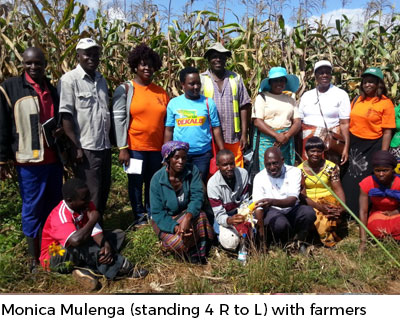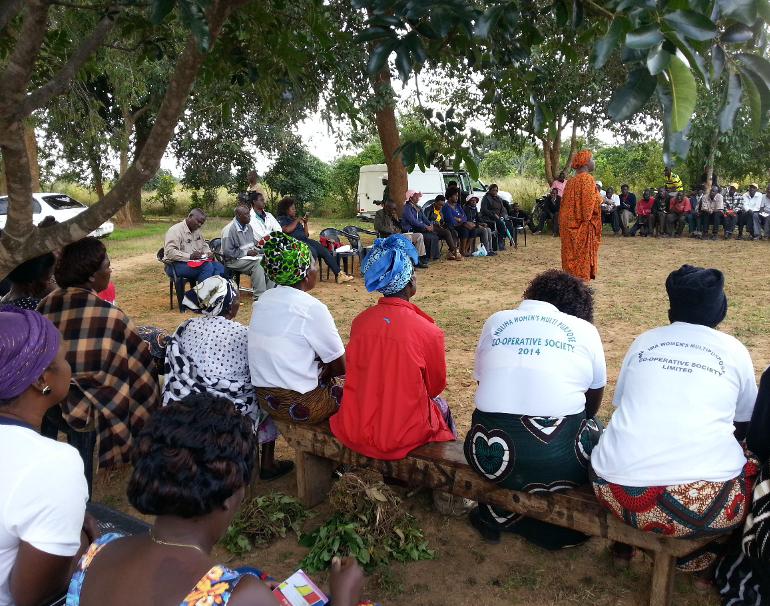As the 2019 HarvestPlus annual report makes clear, the global biofortification movement continues to expand, with more than 40 million people growing and eating these naturally nutritious staple food crops around the world. In addition to the number of people reached, success is also measured by the adoption of relevant government policies – agriculture, nutrition, and health – that include biofortification. To date, 24 countries and several global and regional policymaking organizations have done so, and the momentum is growing. But what does this mean in practice? Are these just prestigious pieces of paper, or are they accelerating access to biofortification?
For Monica Mung’ambata Mulenga, the answer to the latter question is a clear “Yes,” based on her experience as a government agricultural extension officer in Zambia, and concrete evidence she has seen that actions by the government over many years have helped advance biofortification. Mulenga majored in Natural Resource Management and then received an MSc in Integrated Soil Fertility Management from the University of Zambia. She has been an extension officer for the past 14 years in the Kafue and Chilanga districts.
In Zambia, like in many other African countries, agriculture plays a dominant role for people’s livelihoods. With the shift away from mining, agriculture has been identified as one of the key drivers of the economy, representing about 10 percent of GDP and employing 65 percent of the country’s 17.5 million people.
“Having lived in the rural southern part of Zambia, I experienced the many challenges that small-scale farmers face, and I have a comprehensive understanding of the need for improved agricultural technologies,” she said. “This motivated me to learn new, innovative ways to help our small-scale farmers, and when I joined the government as an agricultural extension officer, I was proud of my role as a change agent, bringing advice and solutions to the farmers I serve. I embraced the duty to improve their situation.”
Mulenga talks about her apprehensions when she was first introduced to vitamin A-biofortified maize. She says: “When I first heard about [it], I had a lot of questions: Why is it orange? Will it grow properly? Will farmers adopt it? How does it taste? And will it change the farmers’ livelihood? The more I learned, though, the more excited I became about sharing information and planting material with my farmers.”
Vitamin A deficiency affects 54 percent of Zambian children under the age of five, putting them at higher risk for disease and even death. Biofortified Vitamin A orange maize provides up to 50 percent of daily vitamin A needs. It also provides strong agronomic benefits for farmers: the orange maize is high yielding, disease and virus-resistant, and drought tolerant.
 In partnership with HarvestPlus, Mulenga started conducting training and demonstrations for farmers on growing the vitamin A maize. “Demonstration plots were set up to showcase how well this new maize could grow and farmers were helped to attend farmer field days to observe the crop on the demonstration plots,” she said.
In partnership with HarvestPlus, Mulenga started conducting training and demonstrations for farmers on growing the vitamin A maize. “Demonstration plots were set up to showcase how well this new maize could grow and farmers were helped to attend farmer field days to observe the crop on the demonstration plots,” she said.
“Cookery demonstrations on different consumption methods of orange maize were conducted with various dishes using orange maize prepared for farmers to taste. This excited many farmers and the demand for seed went up. “As for the farmers in Chifwema and Malundu, orange maize became an important crop for them.” Mulenga explained that an increase in adoption was helped by the fact that it began with the household of the village heads. “This has influenced many stakeholders to come on board to help the farmers in marketing the crop and making the seed available,” she noted.
The Government’s Role
The Zambian government recognized early on the importance of biofortified crops, and supported the effort by starting tests of biofortified varieties more than a decade ago. Today, because of the high demand for vitamin A maize seed and grain among small-scale farmers, the Zambian government integrated biofortification into the National Food and Nutrition Strategic Plan and the Farmer Input Support Program (FISP).
The National Plan identifies increased production and use of biofortified foods as a key strategy to reduce micronutrient deficiencies among women of reproductive age, pregnant women, and children under the age of two. It also states that there is a need to increase consumer awareness about the benefits of biofortified crops. The FISP, besides improving the supply and delivery of agricultural inputs to small-scale farmers through sustainable private sector participation at affordable cost, is also ensuring timely access to inputs (including biofortified seed) by smallholder farmers and promoting agricultural diversification.
The Ministry of Health also cleared the way for research that demonstrates that eating vitamin A orange maize improves night vision in young children – an important milestone in the prevention of blindness. This also helps rural farmers who cannot afford to consume vitamin A fortified sugar on a daily basis but can regularly eat vitamin A maize foods. As Maize is Zambia’s staple food, consumed by nearly everyone irrespective of their status, vitamin A maize is a relatively cheaper vitamin A source.
Zambia’s Minister of Agriculture joined African Union colleagues in supporting biofortification at the regional level as part of the AU’s commitment to nutrition-sensitive agriculture. Zambian President Dr. Edgar C. Lungu has even signaled his support by eating vitamin A maize regularly in his household.
Mulenga says: “Today, the farmers I work with have embraced vitamin A maize, turning policy into real-world progress. Their children like the taste; parents see improvements in health; and when drought devastated other maize varieties last year, vitamin A maize survived. I’m glad to be part of my country’s efforts to improve the lives, and livelihoods, of Zambian farmers and consumers.”
Looking ahead, the government is actively considering other measures to bring biofortification’s benefits to more Zambians. For example, the HarvestPlus Zambia team is actively working to engage the Food Reserve Agency (FRA) to include biofortification in its procurement. The FRA relies on the Ministry of Agriculture for guidance and funding for its procurement of crops. In addition, the Ministry of Education procures from FRA for school feeding programs, hence making this a key pathway for biofortified crops to scale in Zambia and reach even more communities.
